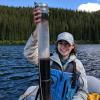February 2023 Tribal Climate Newsletter
Learn more about the Tribal Grid Resilience Formula funding opportunity; the Karuk Tribe's first-of-its-kind training for controlled burns; and more about the Bison Restoration for the American Prairie here.
The Grasslands-Climate Workshop
On January 24-25, 2023 a number of US Fish and Wildlife Service staff and partners working on grassland conservation met in person in Lakewood, CO for the Grasslands-Climate Workshop.
Welcome to Hailey Robe!
The NC CASC is excited to welcome a new program assistant, Hailey Robe, to our staff.
November/December 2022 Newsletter is Available Online
Check out the November/December issue of our newsletter. We strive to update you on NC CASC science, opportunities and events across our region.
Upcoming NC CASC webinar
Drought, despite being an episodic phenomenon, is capable of triggering persistent changes to ecosystems, with important consequences for both biodiversity and human communities.
Contact Us
Want to see more? Do you have feedback? Was this site helpful? Send us an email!



